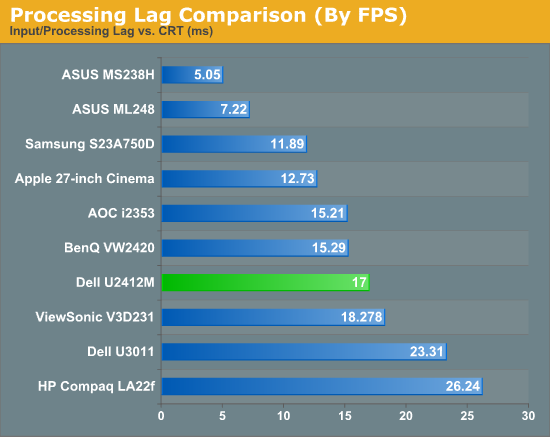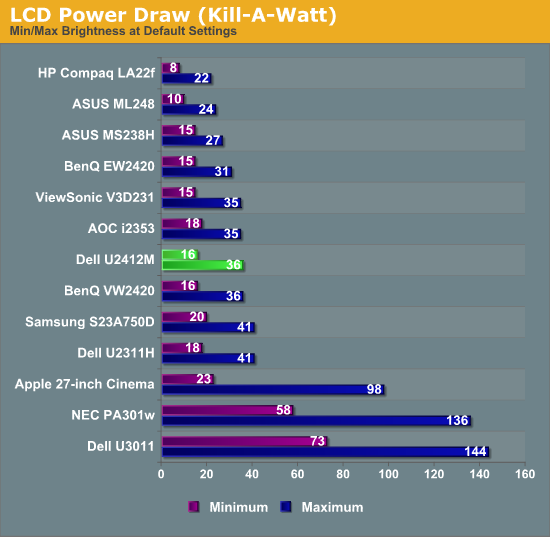Dell U2412M - 16:10 IPS without Breaking the Bank
by Chris Heinonen on February 28, 2012 9:00 AM ESTDell U2412M Input Lag and Power Use
For testing lag, I am trying a new solution to our previous testing method. I’m trying out SMTT, which is designed specifically for measuring lag in LCD displays. Using DirectX it manages to push over 1,000 frames per second to a display, allowing for millisecond accuracy instead of relying on time demos that often run well below that threshold. Using this method, we can actually determine two different values: The input lag for the LCD to initially respond, and then the total lag from when the new frame is received to when it is completely drawn and at full brightness. This last one is the overall important value, as it is what gamers would be most concerned with. It’s important to have as low an "input lag" as possible so that even if the screen isn’t fully drawn yet (the pixels will be changing over) you will be able to begin to get that feeling of responsiveness.

Here we see that the overall lag value measured OK, at 17ms. The input lag, which was also measured, was just under 2ms, which indicates that the Dell responds very quickly, and then it’s just a matter of the pixel response time. One thing to keep in mind here is that the 17ms response time is the total time from input to peak brightness, and then it takes 15ms to fall back to another value. When I actually look at the test subjectively and not objectively, you can certainly see the change in the pixel after 7-8ms of time. So I could report it as 8ms of lag, as that’s about what I think you would experience in a real world situation, but the worst case scenario seems to be 17ms, which is what I’m choosing to report as that’s the objective number.
The CRT still comes in perfect, and that’s what the LCD should aim to do; picking a number that gives a better result, even if it might be more applicable to the real world, feels like cheating. Perhaps we will get a future display technology (like OLED or CrystalLED that I saw at CES this year) that will bring us back to CRT response times, but until that happens I’m going with the objective, worst case measurement. I will report the “real world estimate” along with it, though, so you can use that for your own judgment. Please let me know what you think of this in the comments section.
I made the assumption that with a larger panel and the 300 nits of light output that the Dell would not be the most eco friendly panel I had seen. Happily I found this to not be the case. It drew just 36 watts at maximum brightness and only 16W at minimum brightness, less than even the 23” Dell U2311H from last year. I don’t know if it is more efficient LED lights, or a more transparent panel that allows more light through, but Dell did a good job keeping the power use low on the U2412M.











143 Comments
View All Comments
ExarKun333 - Tuesday, February 28, 2012 - link
Dio you need to be spoon-fed? Dell makes more expensive IPS monitors. You just need to go to Dell.com to see them. U2410, U2711, U3011, etc.DParadoxx - Tuesday, February 28, 2012 - link
I dont because I already own those monitors. The point is to give feedback for the site. Thanks!cheinonen - Tuesday, February 28, 2012 - link
Perhaps a comment like "What I'd like to see in the future are some reviews of 16:10 panels with true 8-bit or 10-bit IPS panels" would be more helpful, since when it just says "Finally a 16:10 review, but its eIPS.... no thanks." I have no idea if you want TN, 10-bit IPS, VA, 120 Hz, etc...kevith - Wednesday, February 29, 2012 - link
Behold, a fair and enlightened rich kid, nice.Touche - Tuesday, February 28, 2012 - link
What are the disadvantages of eIPS?phantom505 - Tuesday, February 28, 2012 - link
6 bit with tricks vs true 8 bit.... read 1st page.Oxford Guy - Tuesday, February 28, 2012 - link
Also, e-IPS has narrower viewing angle than S-IPS/H-IPS.Ratman6161 - Tuesday, February 28, 2012 - link
My older U2410's are also 1920x1200. We also have a slew of Cheap Dell 19 inchers that are 1440x900 which, unless my math is flawed is also 16:10. Paging through their consumer oriented models you do mostly see 16:9. But if you check out the small business section (or corporate or Education\Government) you can find lots of 16:10 options.Death666Angel - Tuesday, February 28, 2012 - link
Did you read the first page? He never said this was new. He said it was where wide screen started and then faded away concerning the budget displays.Considering the price of this monitor, it is a rather new thing to find 16:10 with non-TN panel insides.
Ratman6161 - Tuesday, February 28, 2012 - link
What I'm saying is that 16:10 budget displays never did fade away. You just have to know where to look for them and it will not be with the consumer oriented products. At my office we have at least 60 19 inch 16:10 displays. We got about half of those in mid 2009 and the rest in mid 2011 for about $139 each.